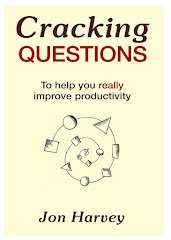Forgive me but...... don't do it!
In my view - mapping processes is a huge waste of time
that saps the creative energy of all those involved. By all means get an
overview of what happens down to a few stages, maybe even unpack some of these
stages to the next level down (what are the 4 to 7 stages within each of these)
but GO NO FURTHER!
To take a radical standpoint - process mapping was
invented by a bunch of business analysts consultants to keep themselves busy.
The police service went for it big time a few years back and look how lean,
unbureaucratic and elegant their processes are now....! This may not be want you want to hear - and I accept I am
adopting an extreme point of view... but I would ask you to think very
carefully about the activities you are embarking on. If I were to take a guess
- you have hired some consultants to come and help you with this...? That or
else you have an ex consultant working internally with you.
My concern centres on innovation. If you map a process to
the n'th degree - I believe that not only are people exhausted by the activity
- they also get so attached to the current way of doing things that they then
cannot 'see the wood for the trees'.
Allow me to suggest an alternative approach:
- Map the process lightly
- Record this on some big pieces of flip chart paper that you can put on the wall
- Find a good cross section of people who have an interest in the success of the process - anyone who knows, cares or can do something about the process. This should include some real citizens, a handful of members, lots of frontline officers, some managers and senior manager or two - the more the merrier really. Don't worry about keeping the numbers small - you can get a 100 people working on this
- Agree a time and place to have an all day meeting with the aim to redesign and rethink the process in question all on that day! Have lots of space, and flip charts, and probably some helium filled balloons too (it helps people find each other)
- Put the process map on the wall somewhere
- Put up questions (see below) around the room to get people thinking about doing things differently - these are all solutions looking for problems (so called inductive problem solving rather than the usual deductive - and often reductive - problem solving)
- Let people loose and encourage people to talk about what they want to talk about to improve the process. (I would advocate using Open Space but there are other large group / whole system methods that could be used too)
- Bring everyone back together at various points to take stock. People will naturally begin to synthesise a new way of running the process.
- Empower a small team to take all the outputs from the day to pull together a summary with clear recommendations for change.
These are the questions to post around the room:
- Have we agreed the stakeholder requirements?
- Are the providers involved adequately trained?
- Are there too many ‘handovers’
- Is the process being done in the right order?
- Could it be made simpler with a ‘triage’ stage?
- Could we make better use of technology?
- Where are the sources of rework?
- Why does performance vary – and by how much?
- Could some parts of the process be done at the same time?
- Are there too many checks and controls?
- Could we get the users / clients / etc. to do more?
- Could we get our partners or suppliers to take action?
- Could we create an expert system to make it work better?
- Is there a ‘standard’ way of carrying out the process?
- Where are the delays in the process?
- Could different people or agencies be providing the service (or part of it)?
- Have we made any cultural or professional assumptions that are getting in the way?
- Are the performance measures helping?
- Could we stop doing the process altogether?
- Are decision making protocols getting in the way?
- Does the process contribute to outcome goals
a) quick
b) efficient
c) liberating
d) creative
e) cuts through parochialism
f) builds a community rather than atomising it with process analysis
g) works with the whole system rather than drawing on Taylorist time and motion methods
etc....
Perhaps we need Process Exploring.... as opposed to mapping?
Perhaps we need Process Exploring.... as opposed to mapping?








.jpg)



I guess you could call what I do 'Process Exploring', it's certainly not the conventional Process mapping. Although working through the process methodically this approach uses an iterative method within a series of workshops to collate and record the improvements suggested by all the participants. It brings multiple teams together and has proved very popular with those involved. Thus it is much closer to Jon's approach than to the conventional As-Is / To-Be methhod.
ReplyDelete